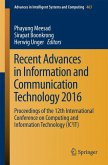This book presents the latest research on computer recognition systems. Over the last few years, computer scientists, engineers and users have been confronted with rapid changes in computer interfaces and in the abilities of the machines and the services available. And this is just the beginning: based on recent research findings, we can expect more significant advances and challenges in the next decade. Achievements in the area of artificial intelligence have made an important major contribution to these developments: Machine learning, natural language processing, speech recognition, image and video processing are just some of the major research and engineering directions that have made autonomous driving, language assistants, automatic translation and answering systems as well as other innovative applications such as morehuman-oriented interfaces possible. Thosedevelopments also reflect economic changes in the world, which are increasingly dominated by the needs of enhanced globalization, international cooperation (including its competitive aspects) and emerging global problems.
Dieser Download kann aus rechtlichen Gründen nur mit Rechnungsadresse in A, B, BG, CY, CZ, D, DK, EW, E, FIN, F, GR, HR, H, IRL, I, LT, L, LR, M, NL, PL, P, R, S, SLO, SK ausgeliefert werden.









